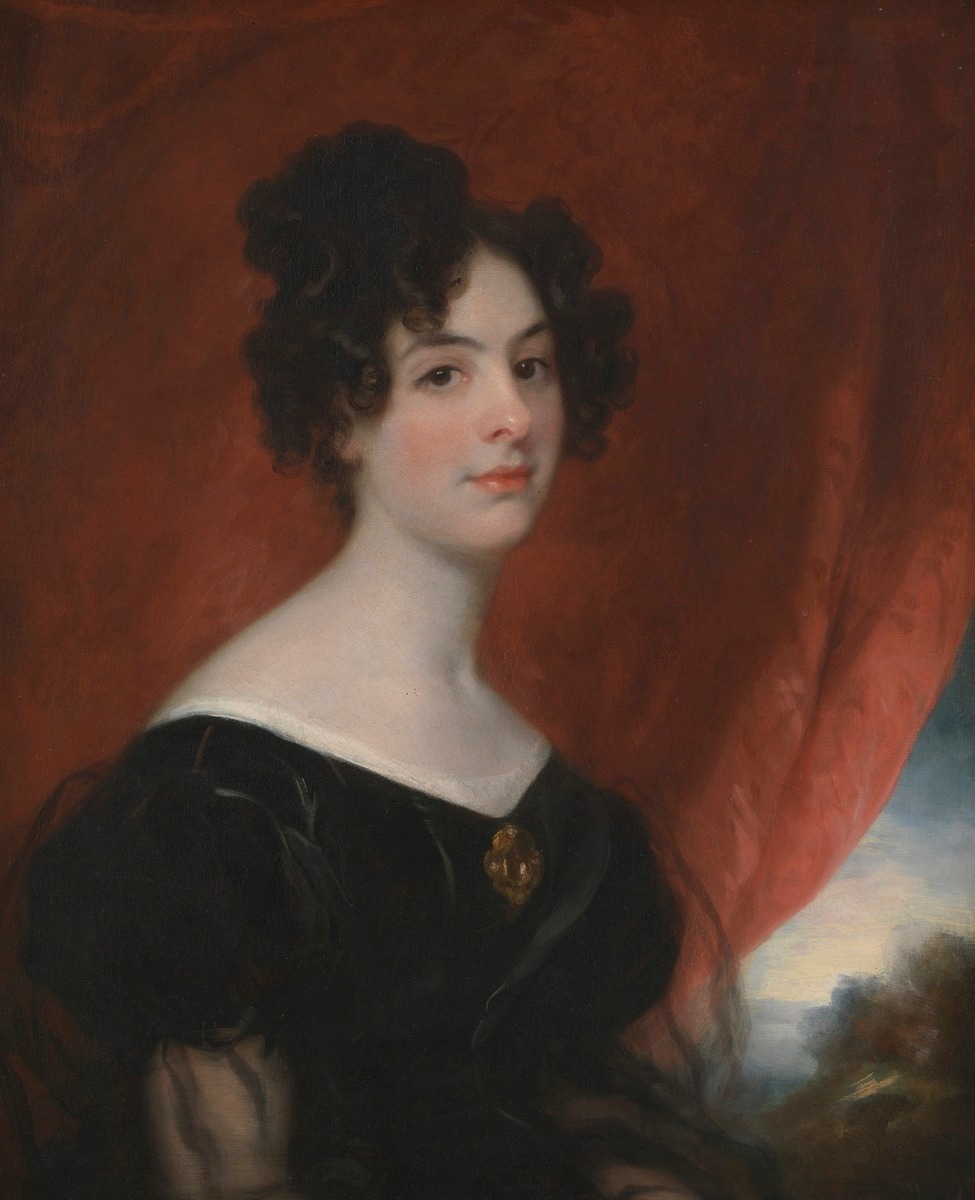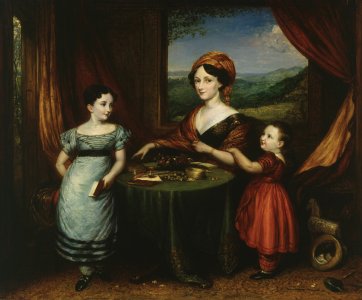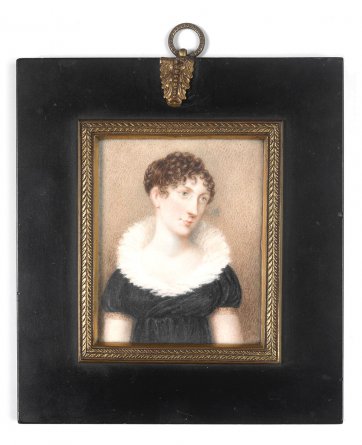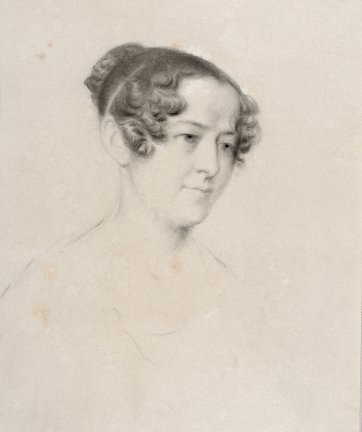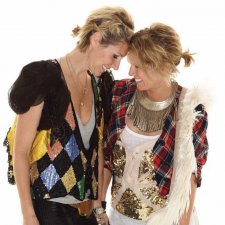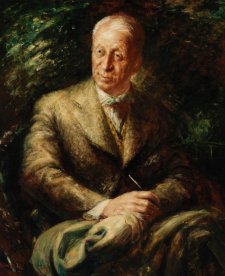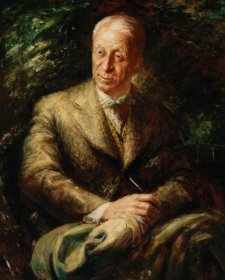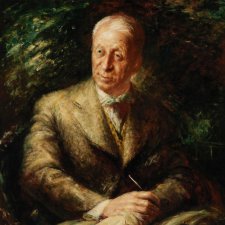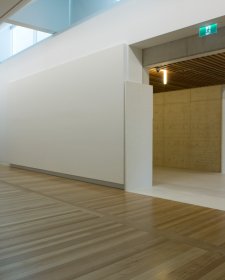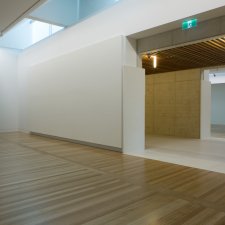She was around twenty-one when painted by the leading London portrait light, Sir Thomas Phillips. She had dark hair, dark eyes, pale skin and – assuming the artist wasn’t ramping up the flattery too much – lovely red lips.
She had beauty and allure enough for her husband to have previously cited ‘wife-sickness’ as a reason for seeking recall from duty overseas. She was accomplished, charming, amusing, well educated and fashionable. To study Ellen Stirling’s story and those of her contemporaries in colonial Australia is often to witness repetition of the same themes – child bearer, charity patroness, ornament or chatelaine – embodying the idea that governor’s wives could be relied on to serve a civilising purpose. Their portraits illustrate the role these women played in the colonial endeavour as the consorts of powerful men, corresponding with the expected performance of a governor’s wife as an instiller of desired feminine traits – grace, sensibility, the right mix of demureness and allure – and an injection of virtue into bawdy, dishevelled colonies where the usual rules on sex and marriage were subject to creative interpretation. One way for a woman to sustain a sense of distinction from the gritty disorder of life in a crude new settlement was to find purpose and spice in the predictable pattern of activities allotted to a governor’s wife. Born in the decades either side of 1800, Australia’s first ‘first ladies’ took the opportunity to toy with their roles before the inflexibility of the Victorian era hardened definitions of ‘correct’ female behaviour.
The daughter of an East India Company director, Ellen Stirling (1807-1874) was thirteen when she caught the attention of naval officer James Stirling. Described by her mother as someone who preferred horses and boats to ‘dancing or conversing sentimentally with the beaux’, Ellen was attractive in the usual ways as well as in her energy and lack of affectation, the smitten Stirling requesting her parents’ permission to marry her when she was still only fifteen. She was married on her sixteenth birthday in September 1823 and just over a year later gave birth to the first of her eleven children. Stirling’s appointment in 1826 to the command of a vessel commissioned for further exploration of Australia’s west coast ultimately resulted in his appointment to the post of Lieutenant Governor of the colony he convinced the British government to establish on the Swan River in 1828. Ellen was pregnant with her second child when she left England in January 1829, landing in what we now know as Perth six months later. Thomas Phillips’s book of sitters reveals that he painted Ellen and other members of her family around the time of her departure for Western Australia, an image for her family to remember her by and a typical gesture marking the movement of a gentleman’s wife to a loftier place on the social ladder. It is a portrait which matches the function she fulfilled as the focus of social attention in the new settlement. Newspaper reports document the ‘amiable deportment’ displayed during her attendance at fetes, balls, race meetings, hunts and other ‘entertainments’. Her maintenance of the obligatory round of official duties, visits to schools, the sick and the bereaved consolidated the reputation that saw her described as ‘a shining example to all classes’. Ellen’s portrait is laced with the conventions which demonstrate her pedigree and rank, but its grace and refinement also belies its subject’s unaffected affability and the vigour she brought to the job of colonial governor’s wife.
Similarly, Eliza Darling’s portrait by John Linnell focuses on her gentility, prefiguring the status she would assume in New South Wales as the wife of Governor Ralph Darling. Painted around the time of her departure for Sydney, the work depicts Eliza with two of her nine children, a companion work to a pair of individual portraits of Eliza and her husband. Eliza (1798-1868) seized on the significant opportunities afforded by colonial service, channelling her evangelical tendencies into philanthropic work, establishing a school for disadvantaged girls, conducting classes for women convicts, supporting charities, and even writing a book of advice ‘for the guidance of persons in humble life’. She also had an interest in architecture and botany and was an accomplished amateur artist, a cheerful, ‘fat little lady’ whose skills as a hostess added some gloss to her husband’s unpopular administration.
Eliza Arthur was another who remained popular and beyond reproach despite to the poor opinions commonly held of a dour husband. She arrived in Hobart with Lieutenant Governor George Arthur in 1824, a ‘respectable’ contrast to the mistress her husband’s predecessor had installed at Government House. She proved a model governor’s wife and set a somewhat wholesome tone for her successors – dutiful, unobtrusive, a devoted mother, an efficient housekeeper and supporter of appropriate causes like orphans and female immigrants. Her small, unassuming portrait by Benjamin Duterrau, whose daughter worked for the Arthurs as a governess, corresponds with descriptions of Eliza as a prim, rigid, even insipid woman who presided over disappointingly sober parties at Government House. But in its simplicity Duterrau’s portrait also says something about a woman who approached colonial service with pragmatism and experience. Eliza herself accepted that as governor’s wife she was ‘obliged to submit’ to sometimes taxing or tedious duties regardless of her poor health and constant childbearing (she had 13 children in less than 20 years).
With less onerous family responsibilities, women like Elizabeth Macquarie (1778-1835) branched into more intellectual pursuits. Elizabeth, described by her husband Lachlan Macquarie as an ‘admirable soldier’s wife’, arrived in New South Wales in December 1809. She is remembered for her unwomanly interest in subjects like road building and architecture and is credited with bringing to Sydney the pattern books that informed much of her husband’s building program. Despite fragile health, she accompanied Macquarie on some of his arduous journeys around the colony as well as maintaining the usual rigorous schedule of formal engagements. Elizabeth also took an interest in the welfare of women convicts and Aboriginal people. A portrait miniature of Elizabeth suggests little of her strong will, offering instead an image of gentle reserve underlined with a hint of the setbacks that attended her married life. Elizabeth’s first child, a daughter, died in infancy, and she suffered several miscarriages before having a child who survived to adulthood. Macquarie deeply valued the practical qualities that made Elizabeth an asset to his work and she remained unfailingly devoted to her husband’s interests despite the messy political environment of his term of office.
Similarly, Jane Franklin (1791-1875) had the unenviable task of inhabiting the fraught political world of Tasmania in the late 1830s. Unlike others, however, Jane’s boots-and-all approach to the role of governor’s wife brought her ridicule as a ‘man in petticoats’, her supposed interference in her husband’s decisions contributing to his recall from office in 1843. Curious, well-travelled, and educated beyond the usual catalogue of subjects deemed fit for women’s minds, Jane and her husband Sir John Franklin came to Tasmania loaded with ideas for promoting the cultural development of the colony. That she was not meek or motherly and took more than a passing interest in exploration, prison discipline and natural history would prove her undoing in provincial, end-of-the-earth Hobart, a long way in every sense from the intellectual London coteries she’d moved in. Tasmanian women were contemptuous of the parties she threw at Government House, preferring the sort of soirees that featured flirting and dancing ‘instead of stupid preaching about philosophy and science’. Jane was forty-five when she arrived in Hobart, and it’s difficult not to think that bitterness against her stemmed partly from the fact that she was childless, middle-aged and no longer particularly pretty. Thomas Bock’s chalk drawing of Jane with its lack of flattery is akin to the coldness felt towards a woman who dared to play too much of a role in building a new society.
With these portraits, the inaugural collection display in the new National Portrait Gallery will help puncture the perception that Australia’s early colonial history reads mainly like a list of military men, revealing instead that the big, masculine narratives of settlement and exploration had a feminine undercurrent. Ellen Stirling’s portrait makes a seductive addition to the National Portrait Gallery’s collection, both for its charm and the link it provides to an individual life that in turn elucidates much about women in colonial Australia
